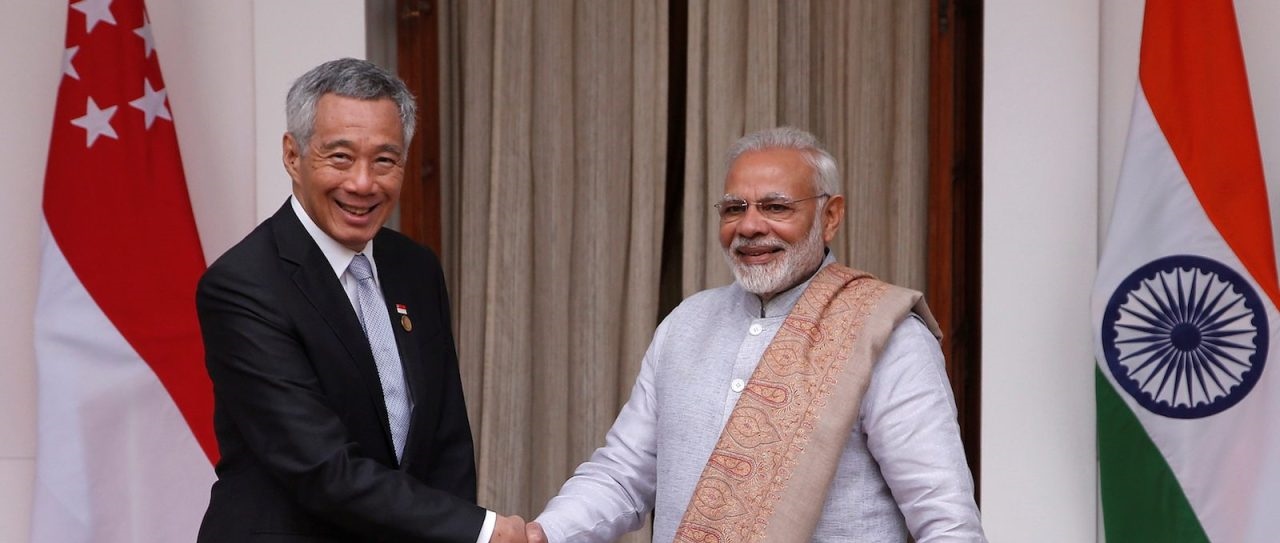Singapore-India to deepen ties
June 2, 2018 | Expert Insights

Indian Prime Minister Narendra Modi met his Singaporean counterpart Lee Hsien Loong for bilateral talks on June 1st. The two leaders issued a joint statement agreeing on bilateral cooperation in areas such as financial technology, urban development and smart cities, cyber security, narcotics control, and defence.
Background
The Republic of Singapore is an island city-state in South-East Asia. Indian relations with Singapore date back to the Chola period. The Chola king Rajendra Chola I conquered parts of South-East Asia, including the port of Tumasik (now Singapore). Singapore was a highly strategic location for the British Empire in India due to its position near the Straits of Malacca, and it was colonised by the British from 1830 to 1867. During this time, it was governed from Calcutta.
The Indian National Army, an armed force led by Subhas Chandra Bose and other Indian nationalists, was formed in Singapore in 1942. The INA was an important part of the history of Indian independence. The INA fought alongside the Japanese Army, which had conquered the region, against British forces. India was one of the first countries to recognize Singapore when it ceded from Malaysia in 1965.
The general election of 1959 brought into power Lee Kuan Yew of the People’s Action Party (PAP), which has remained in power ever since. Lee Kuan Yew served for 30 years and has been credited as responsible for the rapid growth it saw, from a “third world” country to a financial hub, as well as a strictly authoritarian rule. Singapore’s founding father was known for his admiration of both Jawaharlal Nehru and Indira Gandhi.
Singapore has been an important part of India’s Look East Policy since the 1990s. As of 2015, Singapore was India’s 10th largest trade partner globally, and 2nd largest in ASEAN. Bilateral trade stood at $17.1 billion between 2014-15. India and Singapore signed a Comprehensive Economic Cooperation Agreement (CECA) in 2005 and an amendment of the Double Taxation Avoidance Agreement in December 2016. According to some estimates, approximately 8,000 Indian companies are registered in Singapore. Singapore has a large Indian community, and Ethnic Indians constitute approximately 9% of the total population. Tamil is one of the four official languages of Singapore.
Analysis
During Prime Minister Modi’s meeting with Singaporean PM Lee Hsien Loong, the two leaders signed eight agreements including one on logistics cooperation.
Among these agreements was an update on the air services agreement. “An upgrade of this agreement will boost the business and tourism sectors, and bring our two peoples closer together," Lee said. Approximately four million passengers travelled between Singapore and India in 2017. Additionally, the two leaders concluded the second review of the 2005 Comprehensive Economic Cooperation Agreement (CECA). CECA provides Singapore with a number of tariff cuts. Trade has more than doubled since the CECA was signed.
Speaking at a joint press conference PM Lee said, "It shows that our economic ties are substantial and that we want to do more together.” "India is a significant market for Singapore fintech companies, while Singapore, which is a global fintech hub, can be a gateway for India to enter the South-east Asian market." Singapore has approximately $36.3 billion worth of cumulative investments in India.
India and Singapore already cooperate significantly in the defence arena. The two countries have held regular maritime exercises since 1994. India and Singapore signed bilateral agreements on air force training cooperation in 2007, an army agreement in 2008, and discussed increased bilateral naval cooperation in 2017. In recent talks, Modi and Lee emphasised the fight against terrorism, and maritime cooperation.
"Combating cyber security, extremism and terrorism will be an important area of our cooperation in the coming days. We consider them to be among the biggest threats to our countries," Modi said. “We also reiterated our principal stance, as far as maritime security is concerned, our commitment to a rules-based order,” he added, noting that they had “agreed on having an open, fair and transparent maritime trade commitment in this area.”
“Both prime ministers further agreed to India’s proposal for continuous and institutionalized naval engagements in their shared maritime space, including the establishment of maritime exercises with like-minded regional partners,” the Singapore Defence Ministry said in a statement.
Prime Minister Modi has placed significant emphasis on South East Asia in his foreign policy. After coming to power in 2014, Modi rechristened the "Look East" policy to "Act East", with commerce, connectivity and culture as the guiding themes to boost engagement with the bloc. Singapore was the third leg of Modi’s most recent visit to South East Asia. Modi also met with Indonesia President Joko Widodo, and promised to help develop Sabang, a port near the highly strategic Malacca Strait. Modi also met the newly elected Malaysian Prime Minister Mahathir Mohamed in Kuala Lumpur before giving a keynote speech at the Shangri-la Dialogue security forum.
Assessment
Our assessment is that Prime Minister’s Modi’s visit to Singapore will help strengthen India’s ties to a major financial hub. Furthermore, India’s “Act East” Policy is an important part of its strategy to counter China’s influence in the region. While Singapore has maintained a largely neutral position on the South China Sea issue, its strategic location makes it an important partner for India.








Comments